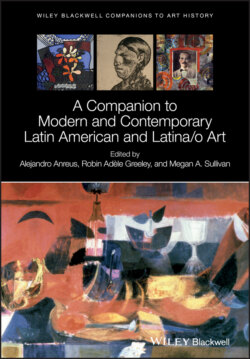Читать книгу A Companion to Modern and Contemporary Latin American and Latina/o Art - Группа авторов - Страница 26
1.2.5 Tepito Arte Acá and Other Alternative Mural Production
ОглавлениеOnce the peak of The Big Three & Tamayo passed, “official” mural painting, that seen on government and commercial buildings, was understood as too closely allied with elitist interests and ossified into academic practice that had little to do with the needs and values of el pueblo, the people. A gigantic, late project by Siqueiros, La marcha de la humanidad (The March of Humanity), of 1964–1971, housed in the Siqueiros Cultural Polyforum in Mexico City, was seen as a pompously inflated and apologist statement related to the corrupt and vicious policies of the government, in light of the state‐perpetrated massacre of students at the Tlatelolco square in 1968. That the patron for this project was the epitome of a capitalist industrialist seriously undermined Siqueiros' self‐proclaimed radicalism. The great Mexican mural tradition has lost its social purpose and political core. But its early history as a viable and vital social art remained in the memories of younger artists, and eventually a grassroots, unorganized, and highly local form of unsponsored, spontaneous, and even guerilla muralism sprung up in the larger Mexican cities.6
The best known of these new groups, Tepito Arte Acá, of the barrio Tepito in Mexico City, evolved in the late 1970s‐early 1980s as a leaderless collective of activists devoted to protecting their unique neighborhood from intrusions by the city government. One of their group, Daniel Manrique, painted large figures on walls facing the street and courtyards, picturing daily lives and concerns of the local Tepiteños. Rough, black outlines of figures were applied to unprepared surfaces and filled in with unmodulated colors. The scaffolding was a tall ladder moved back and forth. This group touched a raw nerve among young artists disillusioned with social ambition and empowered them to develop their own versions of engaged and unofficial wall art.
Mural art has also lately come into museums and galleries, in a substantially modified form but without losing its critical edge. For instance, the wall‐sized installation/kinetic sculpture, Machinarius, 2008,7 by Marcela Armas (b. 1976) first appears to be an abstract shape formed by a bicycle chain connected to gear wheels, mounted on a white wall. The chain is mechanized, turning on these gears and dripping black, crude petroleum along its trail on the wall. The abstract shape quickly and suddenly resolves into the shape of Mexico, upside down, and of course the meaning now is the very opposite of self‐referential abstraction. The petroleum riches of Mexico work only on its borders as export, the interior remains oil poor, and the entire symbol of the country is stained. But the machinery of capitalist corruption is unstoppable. Mural art continues to find new ways to remain relevant on the vital issues facing Mexico.
